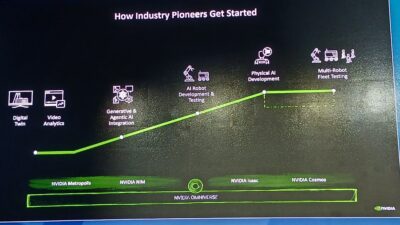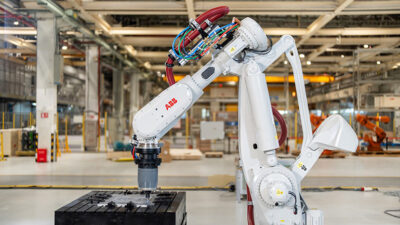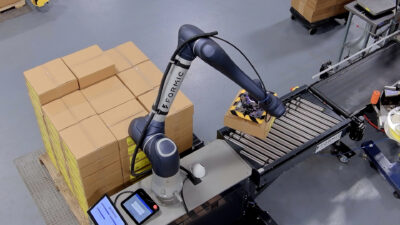Zebra Technologies has acquired Fetch Robotics for almost $300 million, but what does this mean for the company and for other robotics companies? Content partner Interact Analysis offers some insights.

On July 1st, Zebra Technologies announced it would be acquiring Fetch Robotics. It will be paying $290 million to acquire the 95% of the company that it does not already own, in a deal that values Fetch Robotics at $305 million.
Zebra, which provides various warehouse technology such as barcode scanners and printers, has more than 8,000 employees, 10,000 channel partners and generated revenues of over $4 billion in 2020. Fetch was founded in 2014, has 100 employees and generates annual orders of $10 million.
Fetch Robotics is a pioneer in the autonomous mobile robots (AMR) industry and was one of the first companies to develop a commercial autonomous mobile robot for material handling applications. The $305 million valuation may look high on first glance – a valuation of approximately 30 X its annual sales – but it is in line with Locus Robotics’ recent financing round which valued the company at $1 billion. In our view, this valuation shows Zebra believes it can scale Fetch’s sales rapidly, and that its products are unique despite the plethora of vendors now on the scene.
First out of the gates, but quickly overtaken
Despite Fetch’s strong credentials when the company launched back in 2014, it was quickly surpassed by other vendors such as MiR (MiR generated revenues of $40 million in 2020). It is true MiR benefits from a large parent organization following its acquisition in 2018 by Teradyne but, this aside, MiR has always taken a very different strategy to Fetch in terms of growing its business. The company has recruited an army of hundreds of distributors and integrators to sell its mobile robots worldwide. And, although its average fleet sizes are quite modest, the virtual sales team which its distribution network brings has encouraged end customers to start using its robots. The result has been that it has quickly captured market share across the globe.
Fetch, on the other hand, has taken a much more conservative approach. It does not use distributors and has only recently started to partner with major systems integrators, such as Korber. Instead it has mainly developed relationships in-house, targeting major accounts and working more cautiously to refine and perfect its mobile offering. It has retained a strong focus on quality and safety, and also on fleet management software. This perhaps rather too cautious approach has led it to be surpassed by its peers and allowed space for the dozens of new entrants to gain a foothold.
The potential of material handling robots
High-profile acquisitions and valuations such as 6 River Systems ($450 million) and Locus Robotics ($1 billion) are indicative of the extremely rapid pace of growth and the massive total addressable market (TAM) potential for robots used in e-commerce picking applications. Such acquisitions follow in the footsteps of Kiva Systems, which was famously acquired by Amazon for $775 million. But, while robots that assist piece picking benefit from the boom in e-commerce, do mobile robots for general purpose material flow attract the same level of demand?
The answer is a resounding no. Although robots supplied by companies like Fetch are not generally used for e-commerce picking applications, those same warehouses still require movement and management at the pallet level. At the same time labor is as scarce when it comes to forklift drivers as it is for pickers. And demand is further compounded by shifts in manufacturing strategies toward more flexible production lines, which also create demand for mobile robots that can carry larger payloads.
Our recent research has shown that, of the 1.6 million warehouse employees in the U.S., only half of these are conducting piece- or item-level handling. This illustrates the huge opportunity for larger material handling mobile robots to replace human labor. The trend is well reflected in terms of mobile robot revenues – robots designed for non-piece picking applications actually accounted for 52% of AMR revenues last year. Furthermore, revenues from material handling AMRs are expected to reach $3.5 billion by 2024 according to our analysis.
What impact will Zebra have on Fetch’s future?
What does Zebra bring to the table? The answer is a lot. With close to 9,000 employees and sales of $4.5 billion, Zebra has a comparatively massive footprint compared to Fetch. It has thousands of existing customers, and it has built its core business on using its technology to help make its manual workers more efficient and effective. The ability to now offer automation solutions to those same customers is compelling. As well as offering hardware solutions, Zebra’s FulfillmentEdge WES solution makes the integration of AMRs alongside other processes (both automated and manual) even more effective and potentially enticing for customers.
As long as the process of integrating Fetch into Zebra is relatively friction-free, the likely result is this acquisition will turbo-charge Fetch’s growth.
– This article originally appeared on Interact Analysis’ website. Interact Analysis is a CFE Media content partner. Edited by Chris Vavra, web content manager, Control Engineering, CFE Media and Technology, [email protected].



